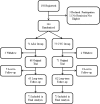Long-term follow-up of cyclophosphamide compared with azathioprine for initial maintenance therapy in ANCA-associated vasculitis
- PMID: 24970876
- PMCID: PMC4152799
- DOI: 10.2215/CJN.00100114
Long-term follow-up of cyclophosphamide compared with azathioprine for initial maintenance therapy in ANCA-associated vasculitis
Abstract
Background and objectives: Treatment with azathioprine within 3 months of remission induction with cyclophosphamide is a common treatment strategy for patients with ANCA-associated vasculitis. This study comprised patients undergoing long-term follow-up who were randomly allocated to azathioprine after 3-6 months or after 12 months of cyclophosphamide treatment.
Design, setting, participants, & measurements: Patients from 39 European centers between 1995 and 1997 with a new diagnosis of ANCA-associated vasculitis that involved the kidneys or another vital organ were eligible. At the time of diagnosis, participants were randomly allocated to convert to azathioprine after 3-6 months (the azathioprine group) or after 12 months of cyclophosphamide (the cyclophosphamide group). Patients who did not achieve a remission within 6 months were excluded. This study assessed relapses, ESRD, and death during long-term follow-up.
Results: Patients were allocated to the azathioprine group (n=71) and the cyclophosphamide group (n=73). Of these patients, 63 (43.8%) developed a relapse, 35 (24.3%) developed a renal relapse, 13 (9.0%) developed ESRD, and 21 (14.6%) died. Although there were worse outcomes in the azathioprine group, none were statistically significant. The subdistribution hazard ratio [sHR] for relapse was 1.63 (95% confidence interval [95% CI], 0.99 to 2.71), the composite of relapse or death hazard ratio [HR] was 1.59 (95% CI, 1.00 to 2.54), the ESRD sHR was 1.71 (95% CI, 0.56 to 5.19), and the death HR was 0.75 (95% CI, 0.32 to 1.79).
Conclusions: It remains uncertain whether converting to azathioprine after 3-6 months of induction cyclophosphamide therapy is as effective as converting after 12 months. Outcomes are still poor for this group of patients and further research is required to determine the optimal timing of maintenance therapy.
Keywords: GN; epidemiology; outcomes; randomized controlled trials; vasculitis.
Copyright © 2014 by the American Society of Nephrology.
Figures


References
-
- Lapraik C, Watts R, Bacon P, Carruthers D, Chakravarty K, D’Cruz D, Guillevin L, Harper L, Jayne D, Luqmani R, Mooney J, Scott D, BSR and BHPR Standards, Guidelines and Audit Working Group : BSR and BHPR guidelines for the management of adults with ANCA associated vasculitis. Rheumatology (Oxford) 46: 1615–1616, 2007 - PubMed
-
- Mukhtyar C, Guillevin L, Cid MC, Dasgupta B, de Groot K, Gross W, Hauser T, Hellmich B, Jayne D, Kallenberg CG, Merkel PA, Raspe H, Salvarani C, Scott DG, Stegeman C, Watts R, Westman K, Witter J, Yazici H, Luqmani R, European Vasculitis Study Group : EULAR recommendations for the management of primary small and medium vessel vasculitis. Ann Rheum Dis 68: 310–317, 2009 - PubMed
-
- Talar-Williams C, Hijazi YM, Walther MM, Linehan WM, Hallahan CW, Lubensky I, Kerr GS, Hoffman GS, Fauci AS, Sneller MC: Cyclophosphamide-induced cystitis and bladder cancer in patients with Wegener granulomatosis. Ann Intern Med 124: 477–484, 1996 - PubMed
-
- Westman KW, Bygren PG, Olsson H, Ranstam J, Wieslander J: Relapse rate, renal survival, and cancer morbidity in patients with Wegener’s granulomatosis or microscopic polyangiitis with renal involvement. J Am Soc Nephrol 9: 842–852, 1998 - PubMed
-
- Little MA, Nightingale P, Verburgh CA, Hauser T, De Groot K, Savage C, Jayne D, Harper L, European Vasculitis Study (EUVAS) Group : Early mortality in systemic vasculitis: Relative contribution of adverse events and active vasculitis. Ann Rheum Dis 69: 1036–1043, 2010 - PubMed
Publication types
MeSH terms
Substances
Grants and funding
LinkOut - more resources
Full Text Sources
Other Literature Sources

